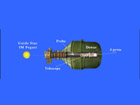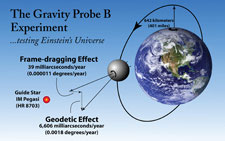WEEKLY HIGHLIGHTS FOR 10 SEPTEMBER 2004:
GRAVITY PROBE B MISSION UPDATE

Just over 20 weeks in orbit, GP-B remains in the Science Phase of the mission.
Gyros #1, #2, and #3 are in science mode, generating relativity data. Alignment
of the spin axis of gyro #4 with the guide star, IM Pegasi, is continuing and
will be completed by early next week.
The spacecraft remains in excellent health, rolling at a rate of 0.7742 rpm
(one revolution every 77.5 seconds). The Attitude and Translation Control (ATC)
system is maintaining a drag-free orbit around gyro #3, and it is properly
tracking the guide star, IM Pegasi, during the portion of each orbit when the
guide star is visible. The Dewar temperature is nominal, and the flow of helium,
venting from the Dewar through the micro thrusters to maintain the drag-free
orbit has remained within expected limits. All other spacecraft subsystems
are continuing to perform well.

On Tuesday, September 7, a double-bit error occurred in a non-critical memory location of the spacecraft’s main (A-side) computer due to a proton hit. This type of error is likely to occur from time to time during the mission. The necessary correction was prepared and uploaded to the proper memory location of the computer. This incident had no effect on science data collection or spacecraft subsystems.
Our statement in last week’s highlights that the GP-B program will not be releasing any scientific data or results until after the completion of the science and instrument re-calibration phases of the mission prompted several inquiries that essentially boil down to two questions: 1) What steps have we taken to ensure the integrity of the raw data and the accuracy of the results? And, 2) Why is it necessary to wait so long before releasing any results?
GP-B’s principal investigator, Professor Francis Everitt, has been quoted on several occasions as saying: " I don't care whether Einstein was right or wrong; what I want is the experimental truth." This is our guiding philosophy here at GP-B. The results of the GP-B experiment will be invaluable to science whether or not they agree with Einstein's predictions. Also, given that this experiment is unlikely to ever be repeated, everyone on the GP-B team feels a great sense of personal responsibility to be as careful and thorough as possible in collecting the data and cross checking our instruments and procedures for accuracy
More specifically, in answer to the first question above, many safeguards
are built into the GP-B experiment to ensure the integrity of the raw
data, the
correctness of the data analysis, and the accuracy of the results. These
safeguards include:
- GP-B is a joint effort between NASA, Stanford, and Lockheed Martin. People
from NASA and Lockheed Martin work on site here in the GP-B facilities at Stanford,
and NASA managers review all GP-B mission activities.
- GP-B has an external Science Advisory Committee, comprised of renowned physicists
and space scientists. That committee has overseen the preparations for data
collection, and it will review all of the data and analysis before the results
are published.
- GP-B also has an independent data analysis team that will be analyzing the
data in parallel with the GP-B science team to corroborate our results. Any
differences in the results of these two teams will be reconciled before the
results are announced.
- The incoming raw data is fed directly into a database and is only available
on a "read-only" basis to the scientists who will be analyzing
it.
- Multiple cross checks are performed to identify any potential systematic experimental
errors. For example, the results of all four gyros are compared and correlated
for consistency.
- During the GP-B experiment, the spin axis deflections of the gyroscopes are measured relative to the guide star, IM Pegasi. But, in order to determine the actual relativistic drift rate of the gyros, we must also measure the proper motion of IM Pegasi relative to quasars (the most distant objects in the universe). The Harvard-Smithsonian Center for Astrophysics (CfA) is measuring the proper motion of IM Pegasi with respect to quasars to an unprecedented level of precision. However, by design, the CfA will not release this proper motion data to the GP-B science team until after the scientific data collection, post-science instrument calibrations, and the data analysis have all been completed. In other words, the relativistic drift rates of the gyros may only be determined once the GP-B gyro drift results and CfA proper motion results are combined.
Regarding the second question of why it is necessary to wait so long before releasing any results, one reason is now apparent: the guide star proper motion safeguard requires that all the GP-B data analysis be completed before we can receive and combine the CfA proper motion data and release/publish the final result. A related technical reason is that while we should have a very good measure of gyro drift after 2-3 months of data collection, it is essential that this data be cross checked and calibrated to ensure its accuracy. We use the annual aberration of our guide star signal (the difference between the actual position of IM Pegasi and its apparent position due to the Earth’s revolution around the Sun) as one means of calibrating the telescope/gryo readout scale factor. Collecting this aberration data over a substantial portion of a year will ensure the greatest accuracy of this calibration.
In summary, we are using utmost care and rigor in our experimental methods and analysis, and only after the analysis has been completed and thoroughly checked will we announce and publish the results. At that time, all of the GP-B data will become available to the public through the National Space Sciences Data Center (NSSDC), located at NASA’s Goddard Space Flight Center in Greenbelt, MD.
Drawings: The two diagrams of the GP-B science instrument and the experimental procedure are from the GP-B Image Archives here at Stanford. Click on the thumbnails to view these diagrams at full size.
Please Note: We will continue updating these highlights and sending out the GP-B email update on a weekly basis through the first few weeks of the Science Phase of the mission. Then, as mission operations become routine, we may reduce the frequency these updates to biweekly. However, from time to time, we intend to post special reports and special updates, as warranted by mission events.
SWISS AMATEUR ASTRONOMER PHOTOGRAPHS GP-B GP-B SPACECRAFT IN ORBIT WITH GUIDE STAR IM PEGASI
To the right, is a thumbnail of a photograph of the GP-B spacecraft in orbit, along with the guide star, IM Pegasi. (Click on the thumbnail to view the photo at full size.) The photo was taken and emailed to us by Stefano Sposetti, a Swiss physics teacher and amateur astronomer. Stefano used a 40cm newtonian telescope, with a CCD camera and 20mm wide field lens attached to make this photo. He then sent us the two versions shown — the normal (black sky) version on the right, and an inverse version in which the constellation, Pegasus, the guide star IM Pegasi, and the path of the GP-B spacecraft are highlighted for easy identification on the left.

We are grateful to Stefano for sending us this wonderful photo. You can view other astronomical photos that he has taken on his Web page: http://aida.astronomie.info/sposetti. Following is Stefano's description of his photo:
In this picture one can see the quite dim GP-B satellite traveling from North (up) to South (down) direction. The bold line in the right part of the left image represents the satellite trail just before entering the earth shadow. (Every satellite becomes visible because it reflects the sunlight). The connecting lines show the constellation Pegasus. The small circle around the star is IM Pegasi, the guide star used by the spacecraft's telescope in his experiment! GP-B is a circumpolar satellite following a free fall trajectory about 640km above the earth surface. From my location the satellite passed that night at a maximum elevation of 87degrees, thus not exactly overhead. The brightness of the satellite was between 3mag and 4mag. The Moon, about in the last quarter phase, illuminated the sky and was a drawback for having a good signal/noise ratio of the satellite trace. I took this 60-seconds black and white CCD picture with a 20mm,f/2.8 lens on august 6 centered at 01:19:00 UT. North is up, East is left.
More links on recent topics
- Track the satellite in the sky
- Photo, video & and news links
- Build a paper model of the GP-B Spacecraft
- Following the mission online
- Our mailing list - receive the weekly highlights via email
- The GP-B Launch Companion in Adobe Acrobat PDF format. Please note: this file is 1.6 MB, so it may take awhile to download if you have a slow Internet connection.
Previous Highlight
Index of Highlights
